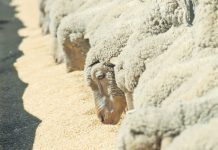
Until recently heartwater was uncommon in the Somerset East district of the Eastern Cape. Unfortunately the transmitter of heartwater, the bont tick (Amblyomma hebraeum) has expanded its range and we started losing stock to heartwater on our farm, the Orchards near Somerset East, in 2008. Regular monitoring of stock showed us there was a heavy bont tick infestation. To deal with the problem we blocked smallstock bi-weekly with tetracycline (a broad spectrum antibiotic) and used a pour-on acaricide on the cattle every two to four weeks, depending on the season.
Blocking stock, although effective against heartwater, was a costly and time consuming exercise. The Onderstepoort heartwater vaccine costs about R25 per animal; with 2 000 animals the costs were more than we could afford. We needed to come up with an alternative solution. After research and on the advice of local vets Brendan Farrel and Jean Louw of the Bosberg Veterinary Clinic in Somerset East, we experimented with making our own blood vaccine.

Graeme Brown
Blooding
Step 1: Preparation. Stock were sorted into manageable groups and relocated to camps close to handling facilities so that animals could be easily treated. Stock was divided into age and type based groups – kids, lambs, adult sheep and adult goats.
Step 2: Infecting the donors. We administered the Onderstepoort vaccine to four of our older goats and monitored them closely. When the rectal temperature rose to above 41°C the goats were bled into blood bags the same as those used by the SA Blood Service. Each animal provided roughly 1l of infected blood. Once bled, the donor goats were treated intravenously with a short-acting tetracycline and cortisone and intramuscularly with a long-acting tetracycline.
We allowed the goats to get very sick before we bled them to ensure high populations of the heartwater organism. Temperatures were checked from day 7. One goat reacted sufficiently by day 12 with a temperature of 41,3°C, another goat showed a temperature reaction by day 15. The remaining two animals showed no temperature spike and were blocked on day 20. One died the following day, the other survived.
Because we bled only the first two goats, we did not get the required quantity of infected blood, and so had to repeat the procedure using three more donor goats. This time all three animals reacted strongly and were bled on day 14. Due to the poor condition of the animals we took only 500ml from each goat. Although they were treated with tetracycline as per the protocol all three died by day 21.
Step 3: Infection of stock. Infection was done in two batches: the first batch with the blood from the first two donors; the second batch about three weeks later with the blood from the second group of donors. The first batch of animals infected included a flock of 604 mature goats and a separate flock of 160 six-month-old kids. The mature goats were injected intravenously with 1,5ml of infected blood and the kids with 1ml.
The vets injected the blood intravenously into the jugular at a rate of about 150 animals an hour. At the same time they instructed me in the technique so that I could manage the process myself in the future. The goats had about six months worth of hair growth which at times made injecting a bit tricky.

A flock of weaned and blooded Dohne Merino lambs running in a lush camp where heartwater is readily transmitted. In the future we plan to blood only replacement ewes.
Effects
Temperatures were checked daily from day 7 onwards from 15 randomly selected goats. The flock was blocked once the average temperature of the sample group was at 41°C. The mature goats reacted on day 12 and were blocked with intra-muscularly administered long-acting tetracycline. Four animals died the following day. On day 14 we followed up with a short-acting tetracycline, repeated on day 17.
There were no further mortalities in this group. On day 15 there was a reaction from the 160 kids. As per the previous protocol, the kids were treated with a long-acting tetracycline followed on day 18 and day 21 with a short-acting tetracycline. Two kids died on day 21, and another three the following day. There were no further losses.
A fine line
We decided to inject the second batch of animals with 2ml of infected blood. The increased dose made a difference to the reaction time of the infected animals. Four separate groups were included in this batch– six Merino rams, 23 Angora kids (stragglers from the first batch), 424 mature Merino ewes and 396 four-month-old Merino lambs. Rams, kids and lambs had all reacted by day 10 and were treated with tetracycline.
In the ewe group, one animal died on day 11, but there was no appreciable temperature rise in the group as late as day 13, when we began the treatment. Despite the fact that temperatures did not spike, we noticed the sheep becoming more lethargic and depressed. By the end of day 13 two more animals had died and 10 died in the next two days.
Delaying the Tetracycline treatment was a costly mistake, but the temperatures did not seem to indicate that we should block any earlier. Clearly there’s a fine line between treating with the oxytetracycline too early not allowing parasite populations to build up, and treating too late, which leaves the farmer with mortalities.
Observations
We noticed a definite correlation between the volume of infected blood injected into an animal and the reaction time. After the administration of 1ml there was a 15 day reaction time down to a 10 day reaction time with a 2ml injection. Since blooding our small-stock, we’ve had no confirmed heartwater deaths. Three months after using our own blood vaccine, our stock have survived the tick onslaught through a warm, wet March and April with no further help from us.
The real test will come when the ticks bite again going into next summer. The two questions we need answered are: “Will this immunity hold out for the winter and carry on into next summer?” And: “Is the tick challenge on the farm big enough to maintain the immunity, or will we have to re-blood every year?”
Going into the summer, we will blood our cattle and a group of 250 Merino ewes that were heavily pregnant when we blooded the small stock. The 2012 crop of kids and lambs due to arrive after winter will also be blooded. – Graeme Brown
Note: Temperatures were taken with a digital rectal thermometer obtained from a chemist. It registered a temperature about 0,3°C higher than that registered by the vets’ mercury thermometer.
Contact Graeme Brown on 079 525 3957, email [email protected]













